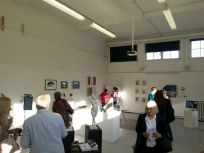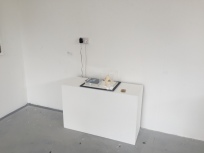
My comments are focused on MA Fine Art Digital, on our first year display, and then on my exhibit ‘Metamorphosis’.
Firstly, the final year exhibits were inspirational and set a high bar for us next year. The range of works was incredible, from paintings by Aurelie, artistic photography by Clara, visual performance by Anthi, sound performance by Manuel, hanging Narwhale skeleton by Jiarqi, abstract picture videos displayed on over 20 iMacs by Donald, to virtual reality by Charles (long listed for the Lumen Prize 2016) to name but a few. In the closing moments of the MA Show Group Crit I expressed my thanks to all the final year students (who had by now all passed their MA, some with distinction) on behalf of the first years. Their exhibits truly made us proud to be part of the MA Fine Art Digital Course. Jonathan’s efforts to get the show up and running were beyond the call of duty and many of all our displays owe a lot to him for their final presentation.
The first year display was impressive too. I won’t go through them all as they were in the same well lit space (shared with MA Designer Maker first year) and are pictured below. Congratulations to all.
There were some lessons to be learned which I hope will be remembered for our final year display.
Firstly, it is up to all of us to help prepare the display space, not just the few who spent a lot of time doing this. My special thanks goes to Celine.
Secondly, we need to help our fellow exhibitors to display the works of online students and others who cannot be there. We cannot leave it up to Jonathan who has enough to do over the show. He put up David’s work and was heavily involved in Yvonne’s, for example. I helped Leonie and Sharon. I am sure others helped too, but I think next year us students should all pull together and only rely on Jonathan for advice with our final displays.
Thirdly, we should resist Jonathan’s suggestion that our exhibits need only be cataloged online (so I am told by Donald). Nick Gorse, our UAL Camberwell Dean offered to pay for a brochure and it was declined. All other courses seemed to have one and they were certainly picked up by many visitors. I am not even sure that visitors were aware that the final year students had an online brochure. We should do both. This means we need to decide on our exhibits in enough time to take pictures and narrate our works in time for the brochure to be produced.
Fourthly, Labels should not be produced at the last minute by UAL Admin. They were a fiasco. No-one had time to check them before the start of the show. As they are transparent they only show on a white background. Whilst the need for consistency is recognised, I personally would have preferred printing in white, so that they showed up on my dark brown plinths. David and Patrick said that they would duplicate the format from this year and make their own, as none of their narrative was included in their labels. I noticed that Clara had to hand write her narrative on her label – and that was for the final year display! Again, we students need to provide our input in good time. Not everybody did so.
Fifthly, the first year display was invigilated by a few people only, and sometimes not at all. Celine and my attempts at getting a schedule together was responded to by a familiar few. Please pull together next year guys and girls.
Sixthly, lets ask that the security personnel do not turn off the power supply to all the exhibits in rooms that need it. We don’t turn off our computers at the plug at home every night, so why do security feel the need to do so? Apparently they need a request from Jonathan. Otherwise, Donald’s 20 odd iMacs need to be rebooted every morning for example. An hour’s exercise. Here are pics of our work after I invigilated one morning and switched the first year exhibits back on.
Some needed Donald’s passwords. Others needed to provide instructions how to bring them to life – including my own with no sound, but we did not provide any documentation about how this could be done. We just cannot let this happen next time. A professor from another art university specifically went to visit mine when I was not there and the sound did not play. How many others visited when these displays were not on? Not very professional and a big disappointment for the viewers.
So we all need to provide this documentation, just in case – there could be an overnight power cut or the security person the night before was not told about the request not to turn off our exhibits.
I would be interested if anyone else has points we could learn from. For our final show we need it to be on time, right first time, well communicated, and everyone must know how to recover the work that they are invigilating.
All that said, we all deserve a pat on the back
Finally, I was very pleased with my exhibit. I managed to combine practically everything I had learned and made during the past year: 3D Scanning, 3D Software, 3D Printing, Lost Wax Bronze Casting, Bare Conductive Arduino with adapted programs (sketches), voice integration using Audacity, proximity sensing and conductive materials. I owe thanks to many (in particular Ed, Jonathan, Becky in the foundry, Billy at CCM digital fabrication, Grzesiek at Wimbledon Digital Media, Chris Fellows and fellow enthusiasts at CCW Digital, and Prof Stephen Farthing at UAL Chelsea) and including all who contributed to my learning experience in any way especially to my fellow first year students and visiting artists who provided a crit of my work.
Over and out on this subject as i now have to get on with my Research Paper.



















 ‘Sequence’
‘Sequence’ 314 words
314 words